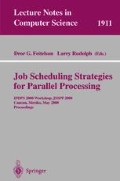Abstract
This note is an elaboratin of a panel presentation, and is meant as a constructive critique of ESP. It should be remembered that the bottom line is that ESP is a big step in an important direction – otherwise we wouldn’t bother with this discussion...
Access this chapter
Tax calculation will be finalised at checkout
Purchases are for personal use only
Preview
Unable to display preview. Download preview PDF.
References
D. H. Bailey, E. Barszcz, L. Dagum, and H. D. Simon, “NAS parallel benchmark results≓. IEEE Trans. Parallel & Distributed Syst. 1(1), pp. 43–51, Feb 1993.
G. Cybenko, L. Kipp, L. Pointer, and D. Kuck, “Supercomputer performance evaluation and the Perfect Benchmarks≓. In Intl. Conf. Supercomputing, pp. 254– 266, Jun 1990.
J. J. Dongarra, “Performance of various computers using standard linear equations software≓. Comput. Arch. News 18(1), pp. 17–31, Mar 1990.
A. B. Downey and D. G. Feitelson, “The elusive goal of workload characterization≓. Perf. Eval. Rev. 26(4), pp. 14–29, Mar 1999.
D. G. Feitelson and A. Mu’alem Weil, “Utilization and predictabilityin scheduling the IBM SP2 with back.lling≓. In 12th Intl. Parallel Processing Symp., pp. 542–546, Apr1998. A Critique of ESP 73
J. P. Jones and B. Nitzberg, “Scheduling for parallel supercomputing: a historical perspective of achievable utilization≓. In Job Scheduling Strategies for Parallel Processing, D. G. Feitelson and L. Rudolph (eds.), pp. 1–16, Springer-Verlag, 1999. Lect. Notes Comput. Sci. vol. 1659.
J. P. Singh, W-D. Weber, and A. Gupta, “SPLASH: Stanford parallel applications for shared-memory≓. Comput. Arch. News 20(1), pp. 5–44, Mar 1992.
A. Wong, L. Oliker, W. Kramer, T. Kaltz, and D. Bailey, “System utilization benchmark on the CrayT3E and IBM SP2≓. In Job Scheduling Strategies for Parallel Processing, D. G. Feitelson and L. Rudolph (eds.), p. 58–70, Springer Verlag, 2000. Lect. Notes Comput. Sci. vol. 1911.
Author information
Authors and Affiliations
Editor information
Editors and Affiliations
Rights and permissions
Copyright information
© 2000 Springer-Verlag Berlin Heidelberg
About this paper
Cite this paper
Feitelson, D.G. (2000). A Critique of ESP. In: Feitelson, D.G., Rudolph, L. (eds) Job Scheduling Strategies for Parallel Processing. JSSPP 2000. Lecture Notes in Computer Science, vol 1911. Springer, Berlin, Heidelberg. https://doi.org/10.1007/3-540-39997-6_5
Download citation
DOI: https://doi.org/10.1007/3-540-39997-6_5
Publisher Name: Springer, Berlin, Heidelberg
Print ISBN: 978-3-540-41120-8
Online ISBN: 978-3-540-39997-1
eBook Packages: Springer Book Archive

